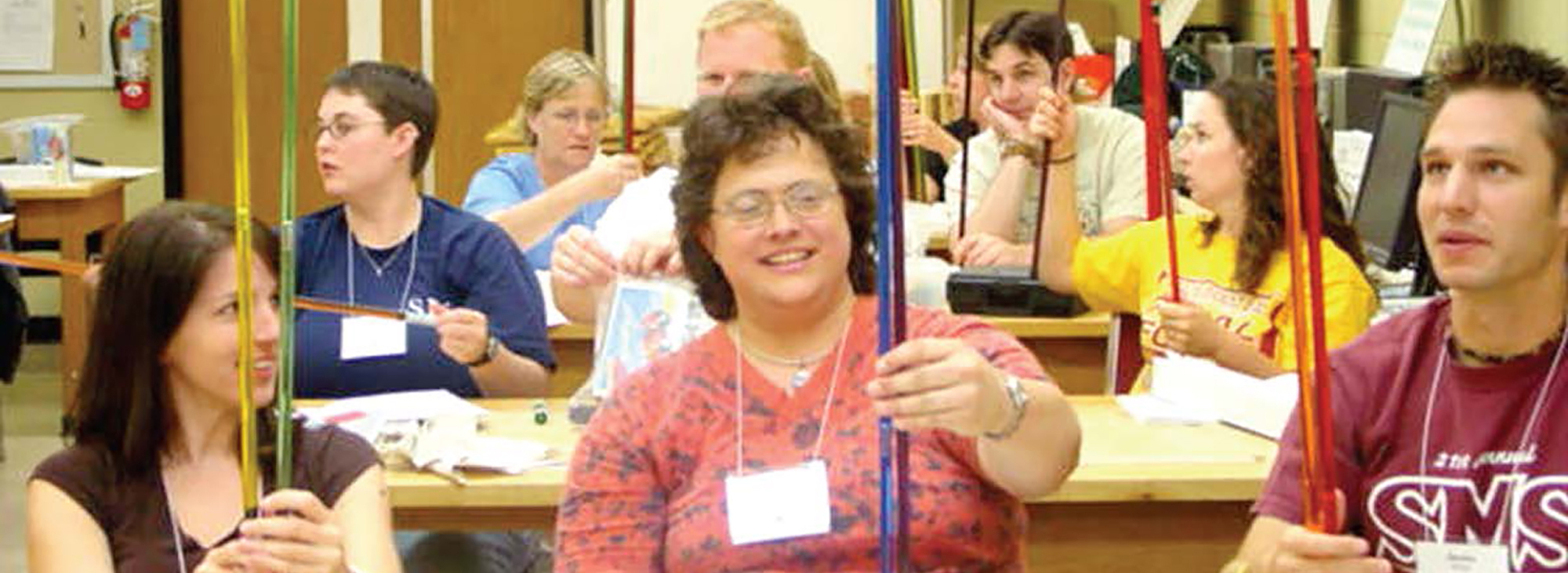Skip to main content
General Resources
Websites
Books
- Bransford, J. D., Brown, A. L., & Cocking, R. R. (2000). How people learn: Brain, mind, experience, and school. Washington, DC: National Academy Press
- National Research Council, (1996). The National Science Education Standards. Washington, DC: National Academy Press.
- National Research Council, (2000). Inquiry and the National Science Education Standards: A guide for teaching and learning. Washington, DC: National Academy Press.
- National Research Council, (2001). Classroom Assessment and the National Science Education Standards. Washington, DC: National Academy Press.
- Missouri Grade Level Expectations, (2005) Missouri Department of Elementary and Secondary Education.
Articles on inquiry-based methods
Articles on Freshman Physics and Physics First
- Agar, O. &Korsunsky, B. (2008). Physics First? Survey First . The Physics Teacher, 46, p.15. http://dx.doi.org/10.1119/1.2823994
- Allen, R. (2004). Shaking up science. Curriculum Update. Alexandria, VA: Association of Supervision and Curriculum Development (reference only).
- American Association of Physics Teachers AAPT, Statement on Physics First.
- Andrews, D., Oliver,M., & Vesenka, J. (2003). Implications of Modeling Method training on physics teacher development in California’s Central Valley. Journal of Physics Teacher Education Online, 1 (4), 14-24.
- Bess, K., & Bybee, R. (2004). Systemic reform of secondary school science, A review of an urban U. S. school district: San Diego City Schools. Presentation for the AAAS/UNESCO International Conference of Science & Technolgy Education, Paris, France: June 7-9, 2004.BSCS Staff (Eds.), (2004). Biology and the physics first curriculum: A symposium celebrating BSCS’s 45th anniversary. Colorado Springs, CO: Biological Sciences Curriculum Study.
- Business-Higher Education Forum. (2005). A commitment to America’s future: Responding to the crisis in mathematics & science education. Washington, DC: Business-Higher Education Forum (reference to report and handbook).
- East Bay Educational Collaborative, Physics first Rhode Island high school reform initiative.
- Giovine, A. (2003). Physics First for ninth-graders is goal of educators at CU conference.
- Glasser, H. M. (2012) The Numbers Speak: Physics First Supports Math Performance. The Physics Teacher, 50, p 53.
- Goodman, Robert and Etkina, Eugenia, Squating the Circle: A Mathematically Rigorous Physics First, The Physics Teacher, 46, 222-227 (2008).
- Haber-Schaim, U. (1984). High school physics should be taught before chemistry and biology. The Physics Teacher, 22, 330 -332.
- Lederman, L. M. (1998). ARISE: American renaissance in science education. Batavia, IL: Fermi National Accelerator Laboratory.
MacIsaac, D., Zawicki, J.; Henry, D., Beery, D., Falconer, K. (2004). A new model alternative certification program for high school physics teachers: New pathways to physics teacher certification at SUNY-Buffalo State College. Journal of Physics Teacher Education Online, 2 (2), 24-32. - Neushatz, M. & McFarling, M. (2003). Broadening the base: High school physics education at the turn of a new century. College Park, MD: American Institute of Physics.
- O’Brien, Michael and Thompson, John R., Effectiveness of Nith-Grade Physics in Main: Conceptual Understanding, The Physics Teacher, 47, 234-239 (2009.
- Pascopella, A. (2005). Chicken and the egg. District Administration, March 2005.
- Pasero, S. (2003). The state of physics-first programs. Fermi Lab Education Office.
- Pattanayak, V. (2003). Physics first in science education reform. Journal of young Investigators,6,(7).
- Popkin, G. (2009). “Physics First” Battles for Acceptance. American Physical Society News, 18, (7).
- Sadler P.M. and Tai, R.H., (2007. The Two High-School Pillars Supporting College Science. Science, 317(5837), 457 – 458.
- (2007) Sheppard, K., & Robbins, D. M. (2005). Chemistry, The Central Science? The History of the High School Science Sequence. Journal of Chemical Education, 82 (4), 561-566.
- Taylor, J., Powell, J.C., Bess, K., & Lamb, T. (2005). Examining the professional growth of out-of-field physics teachers: Findings from a pilot study. Journal of Physics Teacher Education Online, 2 (4), 16-22.
- Tinker, R. (2000). Atomic-scale models: The key to science education reform. The Concord consortium, 4, (1), Winter.
- Wenning, C. J. (2003). Change principles for departmentally-based physics teacher education programs. Journal of Physics Teacher Education Online, 2 (1), 7-12.
- Wenning, C. J. (2004). Repairing the Illinois high school physics teacher pipeline: Recruitment, preparation and retention of high school physics teachers ~ The Illinois model. Journal of Physics Teacher Education Online, 2 (2), 24-32.
- Wilkinson, S. L. (2002). First things first: High school science education is getting turned on its head, with uncertain consequences. Chemical & Engineering News, 80 (27), 34-35.
- Wilt, J. R. (2005). Ninth Grade Physics: A Necessity for High School Science Programs. Journal of Curriculum and Supervision, 20 (4).
